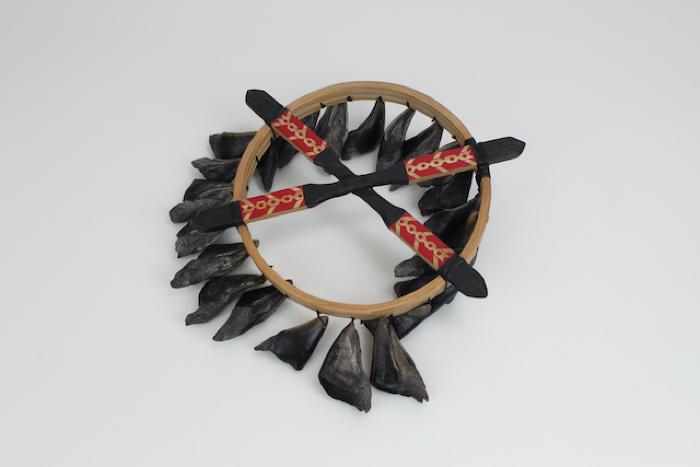Rattle — Kalla'un, Kalla'utaq

The puffin beak rattle is one of two types of Alutiiq rattles. This instrument is made from a set of two to five nested, wooden hoops. Pictures of ancestral rattles show that artists lashed or pegged these hoops to a pair of crossed wooden handles. Then, they attached many puffin beaks, drilling a tiny hole in every beak and lashing them to the hoops. Rattles collected on Kodiak in the early nineteenth century have at least fifty beaks each. Decoration was the final step. Some rattle handles were painted in red and black. Other rattles had feathers attached.
Merck, a German naturalist who visited Kodiak in 1790, observed men dancing with puffin beak rattles. He described the dancers with a rattle or a bundle of feathers in each hand. The men held their arms in the air moving the rattles forward and back, alternating arms.
Alutiiq craftsmen made another type of rattle from two carved pieces of wood lashed together. An example from the village of Ugashik features the face of a bird, with an inset copper eye and an amulet bundle inside. This piece was part of a shaman’s gear.
Loosely translated, the word kalla’un means “magical object” or “shaman’s object”. Rattles were part of the ceremonial gear that helped dancers and shamans interact with the spirit world, a process that involved signing, whistling, drumming, and shaking rattles. The noise brought spirits to the room. The connection between rattles and the non-human world is also seen in the design of the puffin beak rattle. It’s concentric hoops represent the multi-layered Alutiiq universe where circles are passageways between Earth and the sea and sky worlds. Here, birds are powerful creatures that can traverse all layers of the world. They fly in the sky, walk on land, and swim and dive in the ocean. The puffin beaks, feathers, and bird images on rattles channel the power of birds to reach other worlds.
